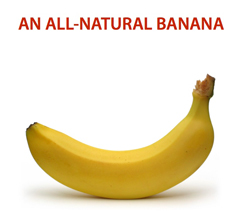Food Chemicals: Can I Eat It If I Can’t Pronounce It?
Return to Heath and Nutrition Agent Articles
For the last couple of years, a common phrase of nutritional advice has been, “Don’t eat anything you can’t pronounce in the ingredients label.” This seems logical and easy advice to follow, unless your diet consists primarily of processed meals, which, in addition to the indecipherable words, tend to be loaded with salt and sugar.
So, then, are processed foods “bad” because of the high salt and sugar content or because of the chemicals? Well, ask yourself this. Would you eat the following item if it contained this label:
Believe it or not, the above label shows the natural ingredients of a banana. A real, organic, non-man-made banana that grows outside on a tree.
So, you see, chemicals aren’t necessarily “bad” for us, because everything we eat is, in its “natural” state, a chemical. In fact, there are many institutions and regulations whose sole intent and purpose is to ensure that everything that involves our food system is safe to consume. The problem, however, is when we over-consume the same types of food, either processed or unprocessed. And when those foods are laced with an overabundance of salt and/or sugar, then our health starts to amass some unwanted consequences.
But, that’s not the fault of the hard to pronounce chemicals. We have to understand that our bodies need a range of nutrients sourced from a variety of foods like vegetables, fruits, grains, dairy and proteins. But, if we only eat one type of food, then we’re denying our bodies the nutrients it needs to sustain good health. We cannot healthfully live on boxed macaroni and cheese alone. But, then again, we also can’t live on unprocessed salad greens, either. We NEED variety in our diets to sustain good health.
The best way to ensure you’re getting a balanced intake of healthy, nutrient-rich foods is to remember the MyPlate image and make half your plate full of vegetables with a handful of fruit.
It is important to note that some folks do have sensitivities to different additives; but this is similar to some people having peanut allergies or lactose sensitivities. The chart below from the Environmental Nutrition newsletter, an Extension-approved source, shows what roles additives actually play in our system, and even examines their potential/assumed risks.
PRESERVATIVES
| Use & Benefits | Keep food fresh |
| Examples | Sodium benzoate, BHA, BHT |
| Risks | Since 1991, California has included BHA on its list of chemicals known to cause cancer or reproductive toxicity. However, the FDA and European Food Safety Authority believe that BHA is safe. |
| Bottom Line | Preservatives approved for us in the U.S. appear to be safe, but if you want to be especially cautious, limit foods containing BHA. |
SWEETENERS
| Use & Benefits | Make foods taste sweet (sometimes without adding calories) |
| Examples | Caloric sweeteners (e.g. high fructose corn syrup); non-caloric sweeteners (e.g. saccharine) |
| Risks | Consuming too much added sugar contributes to obesity and chronic disease. Artificial sweeteners might fuel weight gain rather than weight loss. In some people, artificial sweeteners alter the gut microbiome and promote glucose intolerance, which can increase the risk of diabetes. |
| Bottom Line | Limit added sugars to 10% of total calories (about 13 teaspoons per day for the average person); use non-caloric sweeteners judiciously. |
COLOR
| Use & Benefits | Make foods look appealing |
| Examples | FD&C Blue Nos. 1 and 2; annatto extract |
| Risks | Certain colors may contribute to hyperactivity in children who have attention deficit hyperactivity disorder (ADHD) and a confirmed food allergy. A chemical in caramel coloring, popular in soft drinks, is a potential carcinogen. |
| Bottom Line | Children with ADHD may benefit from eliminating artificial colors, and anyone drinking lots of beverages with caramel coloring should proceed with caution. |
FLAVOR ENHANCERS
| Use & Benefits | Enhance flavors already present in foods |
| Examples | Monosodium glutamate (MSG) and natural ingredients, which either contain MSG or enhance the flavor of it |
| Risks | Some people report adverse reactions to MSG, like headaches and flushing, but studies haven’t found reliable evidence of these reactions, even among those who self-identify as sensitive. |
| Bottom Line | The common sense rule applies: avoid MSG if it makes you feel sick. |
NUTRIENTS
| Use & Benefits | Replace nutrients lost in processing (i.e., in refined grain products), prevent disease (i.e., fortification programs), boost nutrient levels |
| Examples | Folic acid; vitamin D; calcium; and B12 |
| Risks | Consuming more than the RDA (recommended dietary allowance) for particular nutrients can increase health risks. For example, high levels of folic acid can mask vitamin B12 deficiency and potentially accelerate tumor growth. |
| Bottom Line | Added nutrients are generally safe and health-promoting when within 100% RDA levels. For example, folic acid fortification decreased the rate of neural tube defects in babies by 35%. Fortified foods help people get enough calcium, vitamin D and B12. |